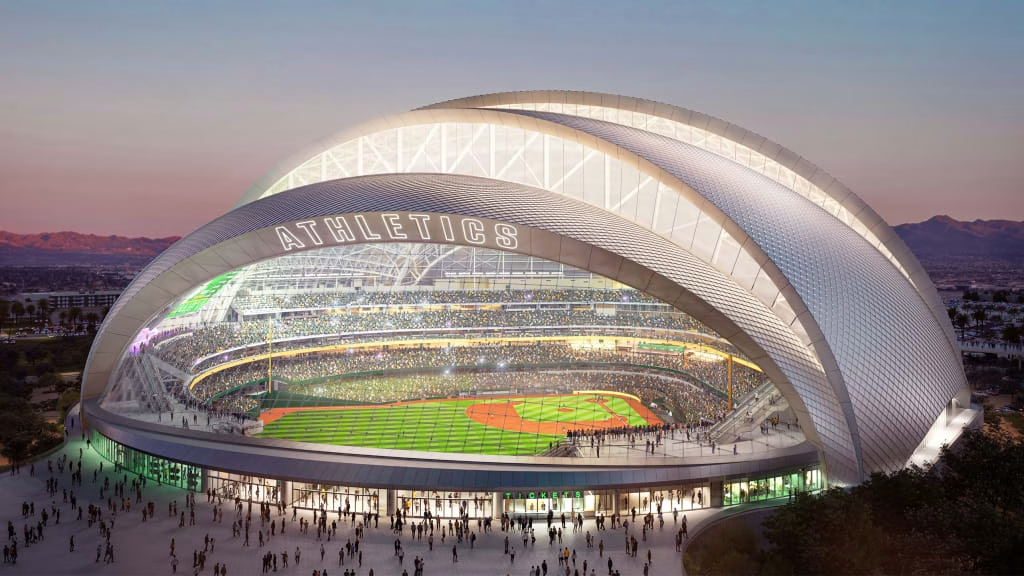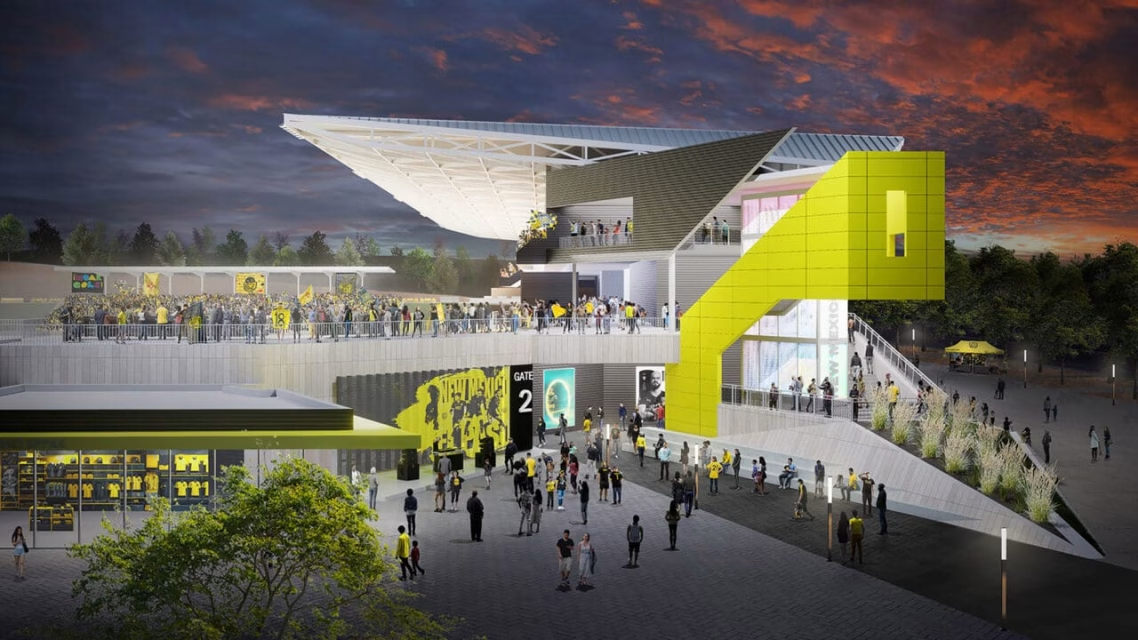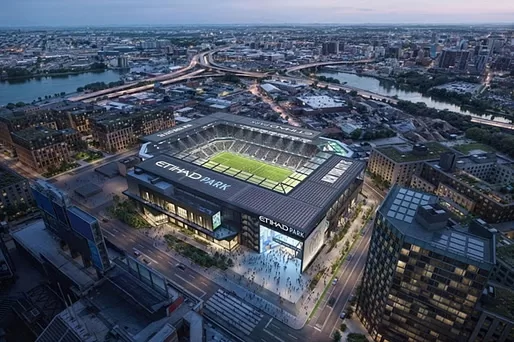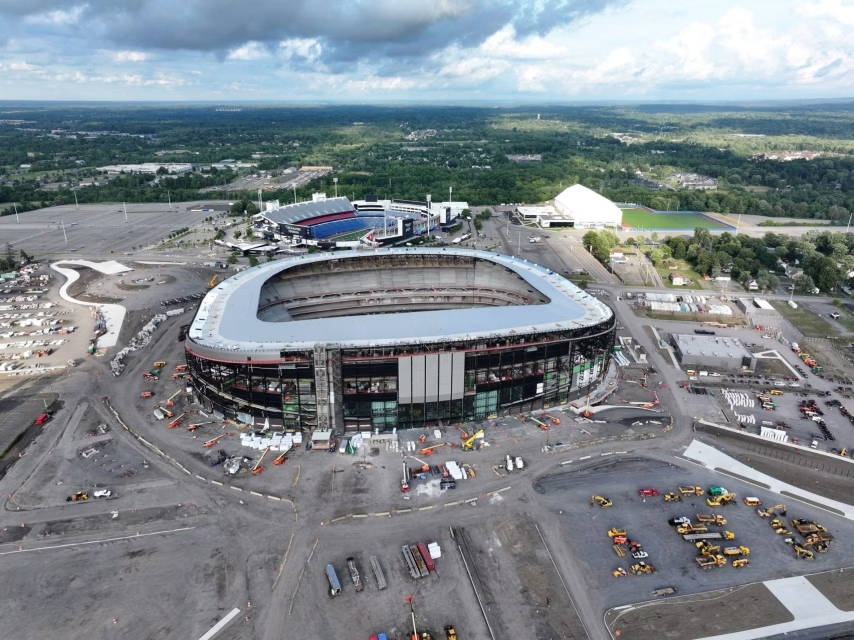The United States is experiencing a new wave of stadi, arenas and parks construction as professional teams, cities, and private investors reshape the sports and entertainment landscape. These projects go far beyond building venues for games—they are designed as mixed-use hubs that combine sports, concerts, retail, housing, and hospitality. Below are some of the significant stadium projects currently underway or planned across the country.
1. Athletics – Las Vegas Ballpark
Major League Baseball’s future in Las Vegas took a decisive step forward on June 23 2025 as the Athletics officially broke ground on their $1.75 billion ballpark at the former Tropicana resort site. The project, located on the iconic Strip, represents both a sporting and cultural milestone for the city, combining baseball with entertainment, retail, and resort amenities.
Designed to seat 30,000 fans with an additional 3,000 standing-room spots, the stadium will feature a fixed roof for desert conditions, split-level seating bowls, and MLB’s largest Jumbotron at 18,000 square feet. Panoramic views of the Strip will make the venue one of the most distinctive in professional sports.
Funded through $380 million in public financing and private investment led by the Fisher family, the ballpark will anchor the team’s relocation from Oakland and mark a new era for baseball in Southern Nevada.
Location: Las Vegas Strip, Nevada
Cost: $1.75 billion
Capacity: 30,000 seats (+3,000 standing)
Opening Date: 2028 MLB season
2. Detroit City FC – AlumniFi Field
Detroit City FC has revealed plans for its future home, AlumniFi Field, a 15,000-seat soccer stadium scheduled to open in time for the 2027 USL Championship season. The facility will rise at the intersection of Michigan Avenue and 20th Street on the site of the long-abandoned Southwest Detroit Hospital, which the club acquired in 2024. City council has approved the demolition of the deteriorated hospital, a $6.5 million undertaking that will be offset by nearly $5.92 million in municipal reimbursement.
International design firm HOK is leading the stadium’s architecture, while AlumniFi, a digital banking app from MSU Federal Credit Union, has extended its partnership with DCFC and secured naming rights. Club CEO Sean Mann described the project as both a landmark for the team and a civic investment in Detroit’s future, with AlumniFi emphasizing community programs and financial literacy alongside the development.
Location: Southwest Detroit
Cost: $150 million
Capacity: 15,000
Opening Date: 2027 season
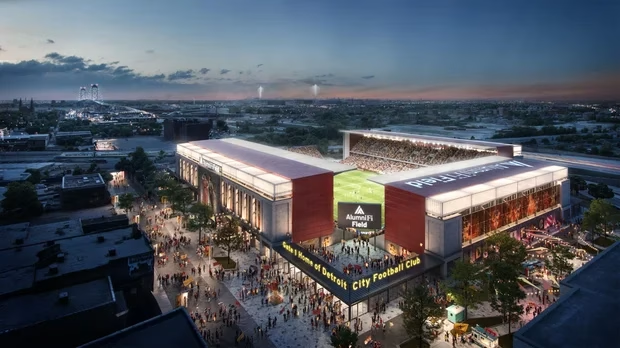
3. Denver Summit FC – Santa Fe Yards
Denver is set to transform Santa Fe Yards with a landmark project: a purpose-built stadium for Denver Summit FC, the city’s new National Women’s Soccer League (NWSL) team. More than a sports venue, the 14,500-seat arena will anchor a 41-acre entertainment district designed to revitalize a former industrial site into a hub of sports, culture, and community life.
Designed by Populous with Civitas, the stadium will emphasize sustainability, walkability, and public green spaces. Its open-air design offers sweeping views of the Front Range, Pikes Peak, and the Denver skyline, while its connection to light rail reflects the city’s commitment to accessible urban development. The surrounding district will feature amphitheater-style lawns, shops, restaurants, and potential housing, ensuring year-round activity beyond matchdays.
Location: Santa Fe Yards, south of downtown Denver
Cost: $70 million (public infrastructure investment)
Capacity: 14,500 seats (expandable to 20,000)
Opening Date: Spring 2028
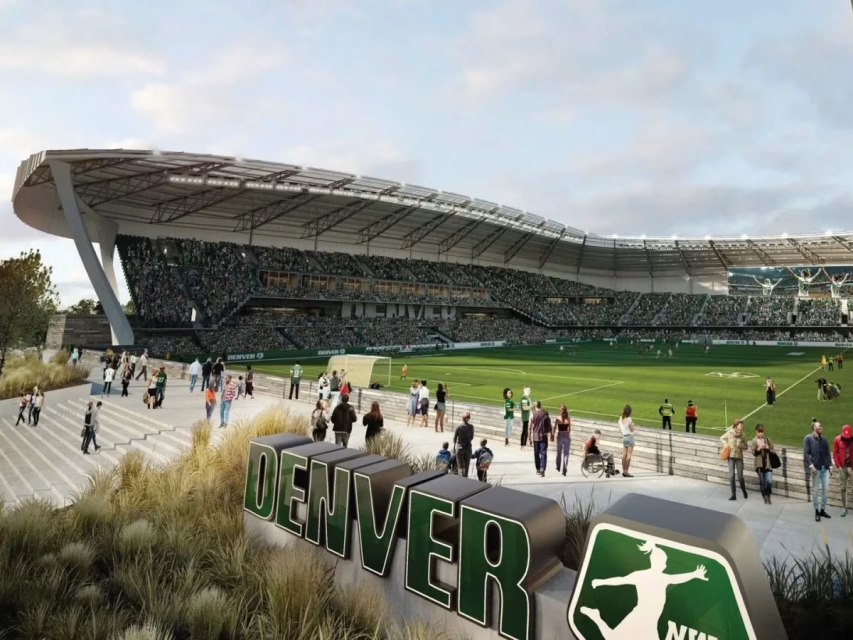
4. Oklahoma City Thunder – OKC Thunder Downtown Arena
In July 2025 Oklahoma City leaders unveiled renderings for the $1 billion OKC Thunder Downtown Arena that will serve as the future home of the NBA’s Oklahoma City Thunder and a premier venue for concerts and events. Revealed during Mayor David Holt’s State of the City address, the design emphasizes both functionality and civic identity, with a striking 360-degree glass curtain wall offering panoramic views of downtown and the Oklahoma sky.
The new arena will rise on the site of the former Cox Convention Center, adjacent to the existing Paycom Center, and is envisioned as a transformative landmark that elevates the downtown skyline. Designed by MANICA Architecture with TVS, and built by Flinto and Mortenson Construction, the facility will combine cutting-edge design with an intimate, electric basketball atmosphere. Funding comes from a 72-month penny sales tax, $78 million in MAPS 4 funds, and a $50 million contribution from Thunder ownership.
Location: Former Cox Convention Center site, downtown OKC
Cost: $1 billion
Capacity: Not disclosed
Opening Date: Summer 2028
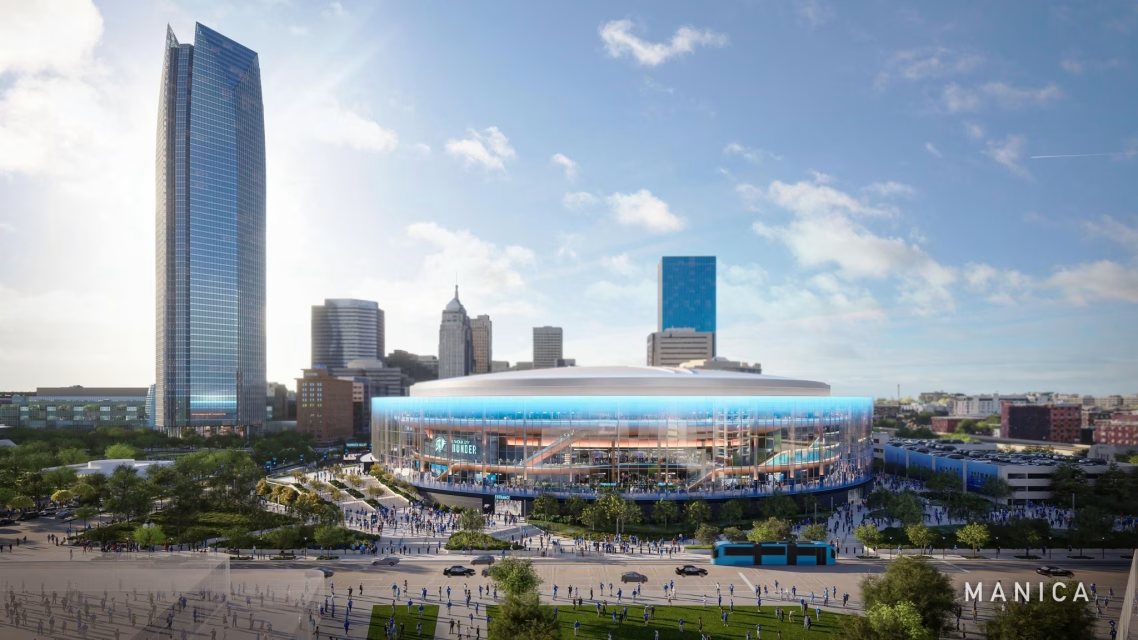
5. New Mexico United Stadium – Balloon Fiesta Park
New Mexico United’s long-awaited permanent stadium at Balloon Fiesta Park in Albuquerque is set to move forward after a district court dismissed a legal appeal that had sought to block the project. Three neighborhood associations had challenged approvals over noise and traffic concerns, but the judge upheld the city’s decisions, effectively clearing the way for construction.
Albuquerque Mayor Tim Keller hailed the project as a generational investment that will serve professional soccer, women’s sports, high school tournaments, and community events. The stadium will also enhance Balloon Fiesta Park, which has recently seen city-funded improvements such as upgraded restrooms, electrical systems, and expanded parking.
Unlike earlier proposals for public financing, the stadium will be built with private investment from New Mexico United, ensuring no city funds are used for construction. The team will finally gain a dedicated, soccer-specific home after years of playing at a converted baseball venue.
Location: Albuquerque, New Mexico
Cost: $30 million (privately funded)
Capacity: 8,000–10,000 seats
Opening Date: TBD (construction to begin 2025)
6. Portland Zidell Yards
Portland’s long pursuit of Major League Baseball took a significant leap forward on June 18, 2025, when Oregon lawmakers approved Senate Bill 110, authorizing $800 million in public bonds to help finance a proposed MLB stadium. The measure, which now awaits the governor’s signature, would leverage future income taxes from players, coaches, and staff salaries, tying the project’s funding directly to the economic activity of the franchise.
The Portland Diamond Project (PDP), leading efforts since 2017, unveiled striking new renderings earlier this year for a 32,000-seat ballpark at Zidell Yards on the city’s South Waterfront. Designed by Populous with a translucent retractable roof and timber-glass architecture, the stadium is envisioned as a year-round community asset.
With bipartisan support and local government backing, Portland is positioning itself as a leading contender for MLB expansion, competing against other hopefuls like Salt Lake City.
Location: Zidell Yards, South Waterfront, Portland, Oregon
Cost: $1.2 billion+
Capacity: 32,000 seats
Opening Date: Targeted for 2027 (if team awarded)
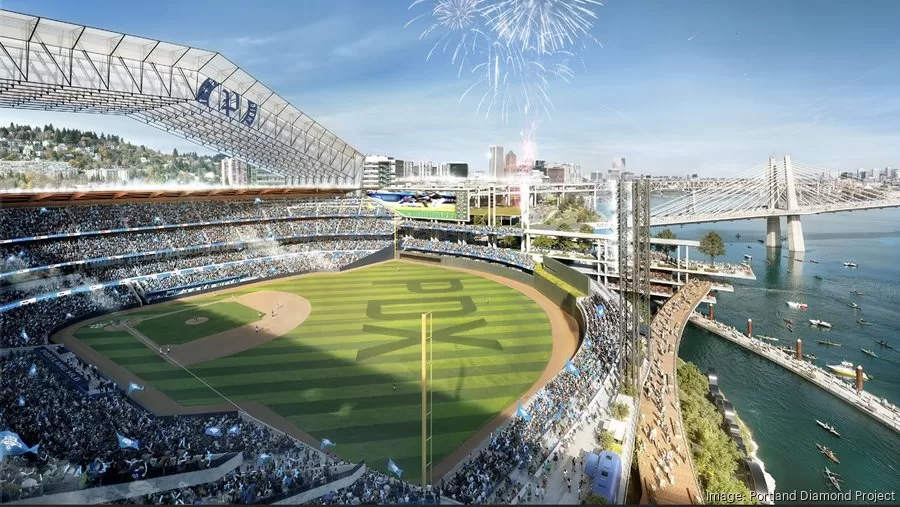
7. New York City FC – Etihad Park
Construction is currenty ongoing on the Etihad Park in New York on the long-awaited soccer-specific stadium for New York City FC in Willets Point, Queens. The project, fully financed by the club, is designed by global architecture firm HOK and represents a major milestone for both fans and the community.
The new venue will transform the neighborhood with modern amenities and sustainable features, including rooftop solar panels, water reuse systems, and a fully electric infrastructure that makes it the first stadium of its kind in Major League Soccer. Beyond sports, Etihad Park is part of a larger Willets Point redevelopment program that will deliver affordable housing, a hotel, retail, dining, and a new public school, creating thousands of jobs in Queens.
The facility will anchor the next era of soccer in New York, reflecting over a decade of planning.
Location: Queens, New York
Cost: $780 million
Capacity: 25,000
Opening Date: 2027
8. Sacramento Republic FC – Railyards
Sacramento Republic FC has officially broken ground in August 2025 on its new soccer stadium in the Railyards on August 18, 2025, marking a major milestone for the club. The $321 million project is designed with an initial capacity of 12,000 seats, with the flexibility to expand to around 20,000 to meet Major League Soccer (MLS) requirements.
The stadium will feature a canopy over the grandstands, upgraded fan amenities, and modern infrastructure to align with league standards. The project is seen as the cornerstone for Republic FC’s long-anticipated move from the United Soccer League to MLS, positioning Sacramento to compete on the country’s premier soccer stage.
Construction is expected to be completed in 2027, with the new stadium serving as both a community hub and a catalyst for economic development in the downtown Railyards district.
Location: Railyards, Sacramento
Cost: $321 million
Capacity: 12,000 (expandable to 20,000)
Opening Date: 2027
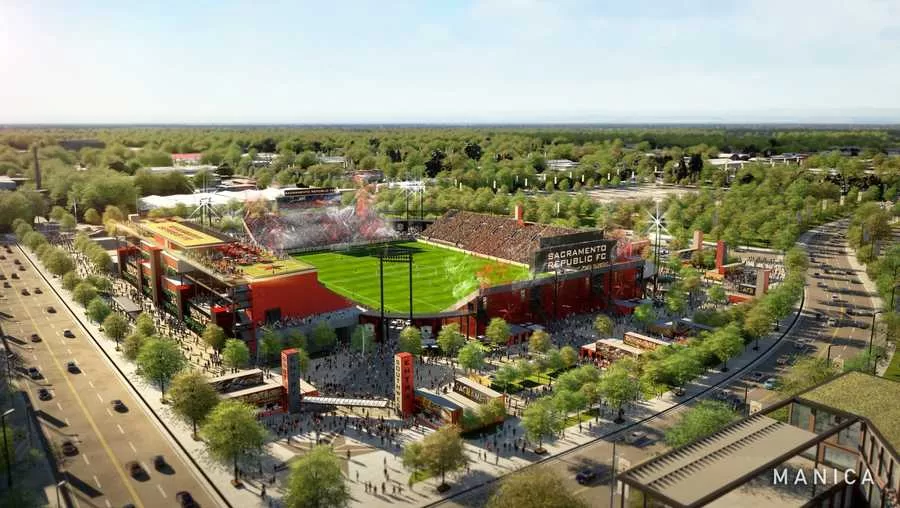
9. The Chicago Fire FC
In June 2025 the Chicago Fire FC has unveiled new renderings for its planned $650 million soccer-specific stadium at “The 78,” a 62-acre development along the Chicago River in the South Loop. Designed by global firm Gensler, the stadium draws inspiration from the city’s industrial heritage, featuring brick, steel, and glass in the “Chicago School” style. The open-air venue will seat 22,000 fans on a natural grass field, with an intimate bowl design that brings supporters closer to the pitch. A steel canopy will amplify light and sound, creating an electrifying matchday atmosphere.
Premium amenities include 50 suites, 500 Loge seats, 3,500 Club seats, and a safe-standing section for 2,000 dedicated supporters. The surrounding plaza will host pre- and post-match events, anchoring the site as both a civic and sporting landmark.
Location: The 78, South Loop, Chicago
Cost: $650 million
Capacity: 22,000
Opening Date: 2028 MLS season
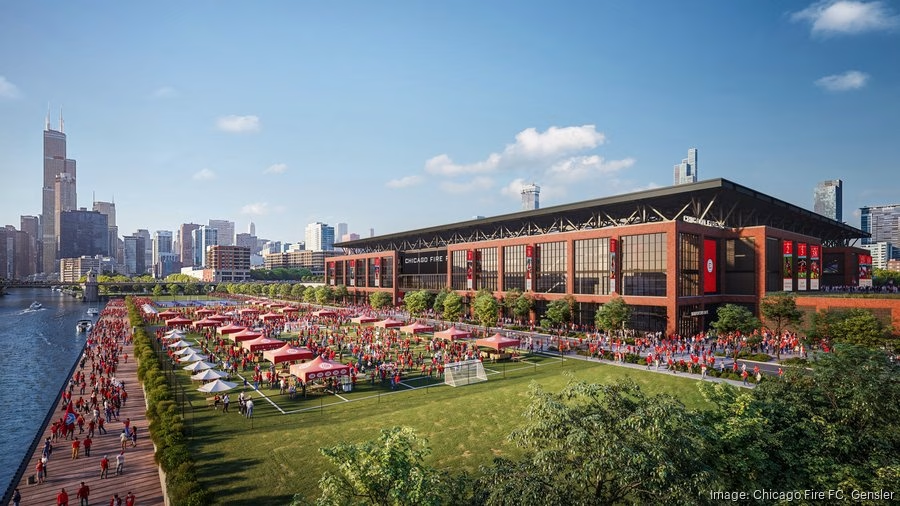
10. Cleveland Browns Domed Stadium – Brook Park, Ohio
The project continues to forge forward with reportsin September indicating that the Ohio Department of Transportation (ODOT) has granted a permit for the Cleveland Browns’ new $2.4 billion stadium. Regulators approved plans for the domed facility after assurances that its structure will not disrupt flight paths.
The Cleveland Browns’ proposed Brook Park stadium project reached a critical stage when Ohio Senate leaders unveiled a plan to provide $600 million in state support in June 2025. Unlike the House’s approach of using state-backed bonds, the Senate proposal taps into $3.7 billion in unclaimed funds, establishing a $1.7 billion Sports and Culture Facilities Fund. From this, the Browns would receive a performance-based grant, repaid over 16 years through tax revenues, with the Haslam Sports Group (HSG) placing $50 million in escrow as security.
HSG has committed over $2 billion in private investment toward the $3.4 billion project, which includes a domed stadium and $1 billion in supporting infrastructure. However, Cuyahoga County Executive Chris Ronayne and Cleveland Mayor Justin Bibb oppose the plan, calling it risky and instead supporting a downtown renovation. Despite resistance, HSG insists on moving forward, backed by NFL Commissioner Roger Goodell.
Location: Brook Park, Ohio
Cost: $3.4 billion
Capacity: ~60,000 seats
Opening Date: Targeted for 2029
11. The Gathering
Forsyth County, northeast of Atlanta, in June 2025 approved the concept for The Gathering, a transformative $3 billion mixed-use development anchored by an NHL-ready arena. Spearheaded by developer Vernon Krause and his Krause Group, the project is seen as Atlanta’s strongest bid yet to bring professional hockey back to Georgia for the first time since the Thrashers relocated in 2011.
At its core, The Gathering features an 18,500-seat arena designed to host an NHL franchise, supported by hotels, retail, restaurants, offices, and nearly 2,000 homes spread across roughly 100 acres near Union Hill Road and GA-400. Forsyth County will issue $225 million in bonds, to be repaid through a tax allocation district, with incentives potentially reaching $390 million.
The suburban location mirrors the Atlanta Braves’ successful relocation to Truist Park, aiming to create year-round economic activity.
Location: Forsyth County, Georgia
Cost: $3 billion
Capacity: 18,500 seats
Opening: TBD, pending NHL approval.
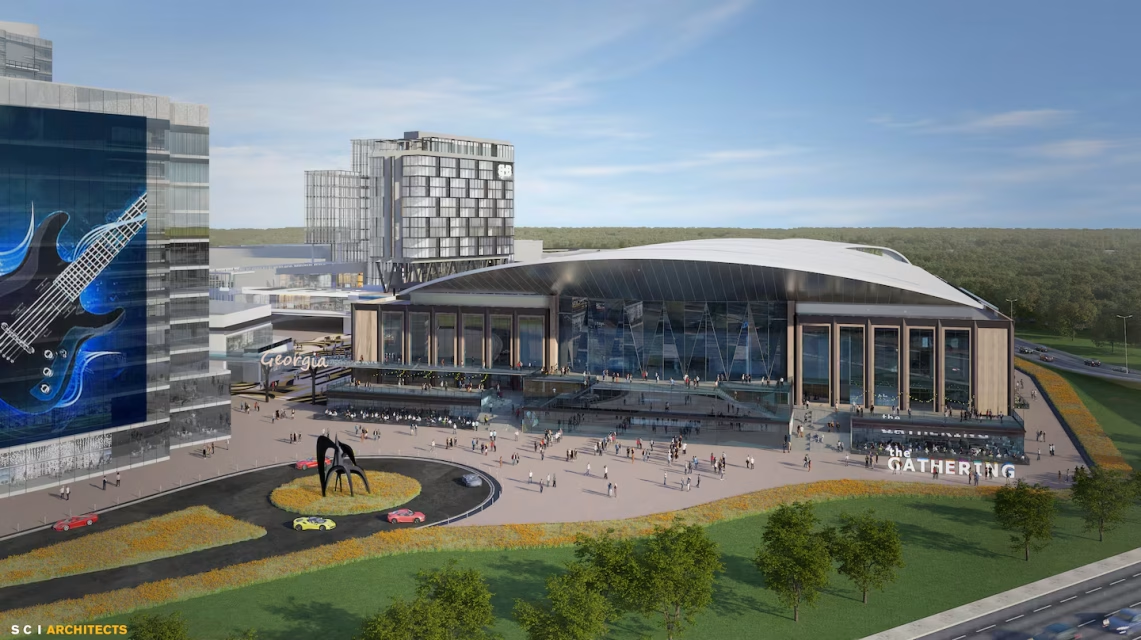
12. David Booth Kansas Memorial Stadium
The University of Kansas has marked the completion of the $400 million redevelopment of David Booth Kansas Memorial Stadium in Lawrence, Kansas, part of the university’s Gateway District initiative. The upgrade involved delivering a multi-purpose venue with premium suites, press boxes, improved concessions, fan experience areas, and a welcoming campus gateway at 11th and Mississippi Street. The Anderson Family Football Complex also received major upgrades, including new training rooms and offices.
More than 1.6 million safe work hours were logged, with the project finished on time and within budget. KU Athletics Director Travis Goff credited the construction team’s commitment, while Turner executives highlighted its lasting impact on students, fans, and the Lawrence community. Now open as a year-round hub for sports, entertainment, retail, and conferences, the stadium will also boost the local economy.
Phase II begins after the 2025 season, adding new seating, a hotel, housing, retail, and office space.
Location: Lawrence, Kansas
Cost: $400 million
Capacity: ~47,000 seats
Opening Date: August 2025
13. The Chicago Bears Domed Stadium in Arlington Heights
The Chicago Bears on Sept. 08, 2025 unveiled a $5 billion plan to transform the 326-acre former Arlington International Racecourse, purchased in 2023 for $197 million, into a domed stadium and mixed-use development. The privately financed venue would anchor a year-round destination featuring restaurants, retail, housing, hotel space, and public parkland, with the project expected to deliver significant economic impact across the region.
Project Overview
Location: Arlington Heights, Illinois (former Arlington International Racecourse)
Total Investment: $5 billion privately financed development
Stadium Cost: $2 billion
Site Size: 326 acres (purchased 2023 for $197 million)
Stadium Capacity: 65,000 – 70,000 seats
Design: Domed stadium with year-round capabilities
14. Tennessee Titans’, Nissan Stadium in Nashville
Construction of the $2.1 billion Nissan Stadium in Nashville has reached its halfway point and is on track for completion in February 2027. About 1,400 workers are active on-site, with topping out expected in November and the ETFE translucent roof installation to follow. The 60,000-seat stadium will feature 130 suites (124 sold), an all-inclusive club, 44 escalators, nearly double the bathrooms, expanded concourses, and 77,000 square feet of LED screens. Fans will be 38% closer to the field. Funded by Metro Nashville, the State of Tennessee, and the Titans, the project will also drive East Bank redevelopment and host major events. The topping out of the Nissan Stadium project was achieved in November 2025 marking a key milestone.
Project Overview
-
Location: Nashville, Tennessee (East Bank of the Cumberland River)
-
Total Investment: $2.1 billion
-
Stadium Cost: $2.1 billion (funded by Metro, State, and Titans)
-
Site Size: N/A (urban site adjacent to existing Nissan Stadium)
-
Stadium Capacity: ~60,000 seats
-
Design: Enclosed stadium with translucent ETFE roof and glass curtain wall

15. The GSR Arena in Reno
Grand Sierra Resort broke ground on its new arena on Sept. 30, 2025, marking the first phase of a multi-billion-dollar investment in Reno. The venue, designed by HOK, will host Nevada’s men’s basketball team, concerts, and a community ice center. Future phases of the master plan include a hotel tower, workforce housing, an ice rink, and a fan zone. Martin-Harris Construction is serving as the general contractor for the project, which is expected to transform the resort into a premier regional destination for sports and entertainment.
Project Overview
Location: Reno, Nevada (Grand Sierra Resort)
Total Investment: Part of a multi-billion-dollar master plan
Arena Cost: $435 million
Architect: HOK
General Contractor: Martin-Harris Construction
Features: Arena for sports and concerts, community ice center, hotel tower, workforce housing, fan zone
16. Sports Performance Hub – Homestead, Florida
South Florida is welcoming a landmark development with the Sports Performance Hub (SPH) — a $280 million, 100% privately funded project set to redefine the intersection of sports, education, and community. Rising on more than 100 acres in Homestead, SPH will feature a 10,000-seat stadium, sports academies, a boarding school, medical and mental health center, 100-room hotel, and year-round residential facilities.
What sets SPH apart amid the growing wave of U.S. stadium construction is its holistic design philosophy — blending athletic training with academic programs, wellness, and social impact. The project aims to generate 4,300 construction jobs and 600 permanent positions, while guaranteeing 10% of academy scholarships for local students. With founding partners including Manu Ginóbili, Juan Sebastián Verón, and Riccardo Silva, the hub represents a new model for community-centered sports infrastructure.
Location: Homestead, Florida
Cost: $280 million (privately funded)
Capacity: 10,000 seats
Site Area: 100+ acres (80-year lease)
Completion: Expected in 2027
17. New Highmark Stadium – Orchard Park, New York
Construction of the new home for the Buffalo Bills the New Highmark Stadium continues to advance, with the stadium reaching its topping-out milestone in April 2025. More than 22,000 steel pieces — weighing approximately 25,000 tons — have been installed, with 60% of the steel sourced from New York State. On October 19, 2025, project leaders released a time-lapse video showcasing the freshly completed natural-grass playing field, signaling a transition from major structural work to interior finishing. Current efforts are focused on the roof canopy, exterior glass, and precast panels, while final site work continues ahead of the 2026 NFL season. The $2.1 billion development remains one of the largest and most closely watched stadium projects in the U.S. In December 2025 the project had attained 75% completion
Location: Orchard Park, New York
Cost: $2.1 billion
Capacity: ~60,000 seats
Opening Date: 2026 season
